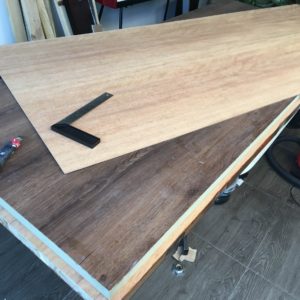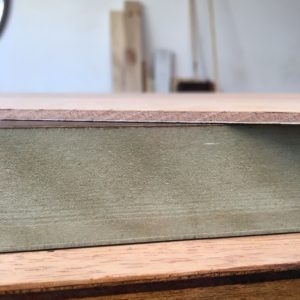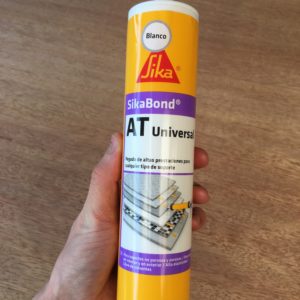Hi all,
First post here, and a very specific question. I am building a door for my recording studio, and without going in to too much detail, I need to attach a veneer to the back of the existing door. Photos attached…
As you will see, the door consists of two door slabs attached to each other, one slightly smaller than the other (larger slab underneath is solid seike, smaller slab on top is MDF). The smaller MDF door already has a veneer attached.
What I want to do is attach a new 3mm veneer on top of this (photo attached), so that I can stain and varnish it to match the bigger door slab underneath (solid seike, regional to Ecuador where I live: https://www.woodweb.com/cgi-bin/forums/cabinetmaking.pl?read=800232). The new veneer is also seike.
My plan was to attach with a combination of glue (actually was going to use SikaBond Universal), along with nails. In terms of finish, I don’t mind the nails showing, I just don’t want it to fall off! Few questions come to mind…
1) can I apply the bonding agent/veneer directly on top of the current veneer? Or would I need to strip the current veneer off..(?!)
2) What is the best kind of bonding agent to use? I mentioned SikaBond Universal above, but it might not be the best. I know specific veneer glues exist, but given that this isn’t a paper thin veneer, perhaps the SikaBond would be OK?
Note that the new veneer is not the typical paper-thin veneer, such as is currently on the MDF door. It’s a 3mm seike veneer.
Thank you!

















Replies
If the current veneer is sound and firmly attached you should just scuff sand very well with 120 grit paper on a random orbit. I would go with contact cement for the veneer rather than the caulk tube. Apply it with a roller and press it with a J roller. Follow the dry time & instructions on the contact cement can. If you dont have a j roller you can shuffle on it in socks to squeeze it down.
When you place the veneer it is a one-try event. Float the veneer above the door on dowels and press strating in the middle working out towards the ends and edges, pulling dowels as you go. Leave the veneer oversized and trim it flush with a router after bonding.
I agree with MJ. I would only add that you should be sure to apply the contact cement to both surfaces. Also, year ago, I had very poor experience with water based contact cement. Maybe it has improved in recent years. To be safe, I would recommend solvent based.
Thank you both for your comments. Yes the current veneer is very firm, its a brand new MDF door. Unfortunately the veneer is already cut to size, so I'll just have to be extremely careful when I place it!
There isnt an abundance of availability of things here in Ecuador. If I can only find water-based cement, would I be better off with the caulk that I posted? Or would water-based cement still be more suitable?
I would suggest that you test WB contact cement on a different project or on scrap. I had poor experience with it years ago and I have read other negative comments. So, I can't give better advice.
Another option is to use plastic resin glue and apply it with a small short nap roller to both surfaces. I have had very good results with this. The down side of this is it needs to be pressed down while the glue dries and it will have a tendency to slip out of alignment as you clamp or add weights. If you can solve these issues, it will work great.
I'm not familiar with the caulking gun glue you have. But, I would be concerned about getting it spread thin and even. Any unevenness could telegraph through the veneer. Again. Test it on something else first. Their website says it has good initial tack (which would be good) and dries fast (which might be a problem). So, can you spread it fast enough over the entire area to allow for alignment and clamping before it dries?
Considering you have already cut to size I would not go with anything BUT a contact cement. If you have to clamp it and do not have a vac bag setup it will creep on you or not adhere evenly.
The water based products got a bad rap because their first usere were ill-informed...as a result of not reading the can. Solvent based glue flashes off quickly, letting you join a project pretty quickly. Early adopters had that clock in their heads and trapped water caused failed bonds.
Water based glues set up slowly because water evaporates more slowly, especially on a humid day. Coat both surfaces and let it dry to where when you touch it the glue feels pretty sticky but will not come off on your finger. An air conditioned room is your friend here. BOTH surfaces should look a bit shiny, on raw wood that could mean more than 1 coat.
Attach a raised edge to your door to position the veneer properly and follow the pattern I put in my first post.
This forum post is now archived. Commenting has been disabled